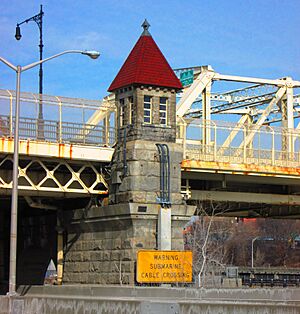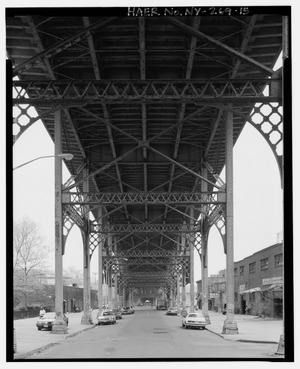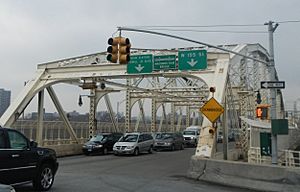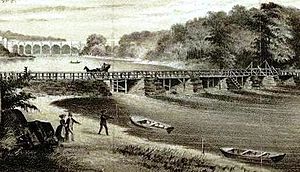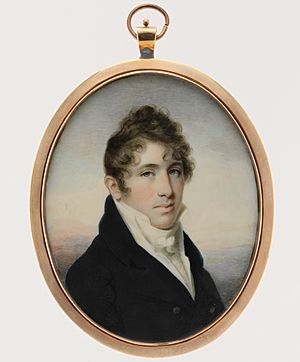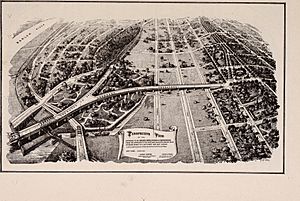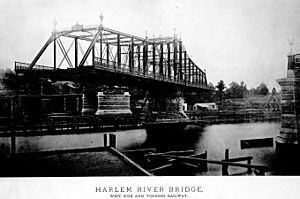Macombs Dam Bridge facts for kids
Quick facts for kids Macombs Dam Bridge |
|
|---|---|

View of the over-water span from the south; the Bronx approach viaduct can be seen at right
|
|
| Coordinates | 40°49′41″N 73°56′02″W / 40.82806°N 73.93389°W |
| Carries | Four lanes of vehicular traffic |
| Crosses | Harlem River |
| Locale | Manhattan and the Bronx, New York City |
| Named for | Macombs Dam |
| Owner | City of New York |
| Maintained by | NYCDOT |
| Heritage status | New York City designated landmark |
| Preceded by | High Bridge |
| Followed by | 145th Street Bridge |
| Characteristics | |
| Design | swing and camelback bridge |
| Total length | 2,540 ft (770 m) |
| Longest span | 408 ft (124 m) |
| Clearance below | 25 ft (7.6 m) |
| History | |
| Construction cost | $24 million (viaduct, in 2022 values) $46 million (over-water span, in 2022 values) $181 million (rehabilitation) |
| Opened | May 1, 1895 |
| Statistics | |
| Daily traffic | 38,183 (2016) |
The Macombs Dam Bridge is a swing bridge that crosses the Harlem River in New York City. It connects the areas of Manhattan and the Bronx. The New York City Department of Transportation (NYCDOT) takes care of the bridge.
The Macombs Dam Bridge links 155th Street and Adam Clayton Powell, Jr. Boulevard in Manhattan. It connects to Jerome Avenue and 161st Street in the Bronx, which is close to Yankee Stadium. A part of the bridge in Manhattan, called the 155th Street Viaduct, carries traffic on 155th Street. The entire bridge is about 2,540 feet (770 m) long. It has four lanes for cars and two sidewalks for people walking.
The first crossing here was a dam built in 1814, named Macombs Dam. People complained that the dam made it hard for boats to travel on the Harlem River. So, in 1858, the dam was taken down. A wooden swing bridge, called the Central Bridge, replaced it in 1861. This wooden bridge needed a lot of repairs. The bridge we see today is made of steel and was built between 1892 and 1895. The 155th Street Viaduct was built a bit earlier, from 1890 to 1893. Both were designed by Alfred Pancoast Boller. The Macombs Dam Bridge is the third-oldest major bridge still used in New York City. In 1992, it became a New York City Landmark, along with the 155th Street Viaduct.
Contents
What the Bridge Looks Like
The Macombs Dam Bridge is named after Robert Macomb. It has two main parts: the section over the water and the 155th Street Viaduct. Both parts were designed by engineer Alfred Pancoast Boller. The bridge is about 2,540 feet (770 m) long in total, including its connecting roads.
As of 2019, the Macombs Dam Bridge carries the Bx6, Bx6 SBS bus routes. In 2016, about 38,183 vehicles crossed the bridge each day. The busiest year was 1957, when over 55,000 vehicles used it daily.
The Part Over the River
The Macombs Dam Bridge has a swing bridge section over the Harlem River. This part can turn around a small island in the middle of the river. It is the oldest swing bridge in New York City that still has its original design. The NYCDOT says it's the city's third-oldest major bridge still in use. This swinging part is about 408 or 415 feet (124 or 126 m) long. It has four lanes for cars and a sidewalk on each side for people. The road is 40 feet (12 m) wide, and the sidewalks are about 9.9 feet (3.0 m) wide. The total width of the bridge deck is 65 feet (20 m).
The bridge's design includes curved metal frames called chords at the top. These frames get taller towards the middle of the bridge. On the Manhattan side, there's a plaque that says "Central Bridge" and the year 1894. The design of the bridge's ends has been compared to a fancy crown. The swing part can turn on a tower located on the small island in the river. When the bridge is closed, boats have 25 feet (7.6 m) of space to pass underneath. The swinging part weighs 2,400 short tons (2,100 long tons; 2,200 t). It is turned by two large drums. When it was built, this part of the Macombs Dam Bridge was one of the biggest movable bridges ever made.
On both sides of the river, there are pairs of stone piers with small houses on them. These houses are used by the bridge operators. Metal gates are near these piers. They block access to the bridge when it is open for boats. Some of the original railings on the bridge have been replaced over time.
Bridge Approaches
The bridge has three main ways to get onto it. Two are from the Manhattan side, and one is from the Bronx side.
155th Street Viaduct
At the western end of the over-water span is a long steel bridge called a viaduct. It carries two sidewalks and two lanes of traffic in each direction. This viaduct goes from 155th Street, Edgecombe Avenue, and St. Nicholas Place on the west. It ends at Macombs Place, Macombs Dam Bridge, and Seventh Avenue on the east. There are traffic lights at both ends of the 155th Street Viaduct. A lower part of 155th Street runs on the ground underneath the viaduct.
The viaduct is about 1,600 feet (490 m) long. It was built because of a high cliff called Coogan's Bluff at its western end, which is about 110 feet (34 m) above the river. The viaduct goes over a lower section of 155th Street at the bottom of this cliff. It is held up by 31 large steel beams. The western end of the viaduct sits on a stone base. The road still has its original fancy iron railings. There are also tall chain-link fences for safety.
The viaduct was designed to look like a park road. It had special viewing areas that stuck out from the sidewalks. Also, four long metal staircases used to connect the viaduct to the lower part of 155th Street. By 2000, these stairs were too old to be fixed. On the western end, a stone staircase still connects the viaduct's north sidewalk to the lower 155th Street. A 28-foot-tall (8.5 m) column with a weather vane, lamp, and drinking fountain is at the viaduct's western end. This fountain, sometimes called the Hooper Fountain, is still there. Near the column, a path leads to Jackie Robinson Park.
Before the viaduct, getting to the 155th Street subway station at the bottom of the cliff was hard. You had to use a very long staircase. In 1890, a magazine said that wagons had to travel a mile or more out of their way to go up the hill.
Seventh Avenue Approach
Another way to get onto the bridge is from Seventh Avenue and Macombs Place. This approach is about 140 feet (43 m) long. It is supported by steel beams and trusses. Part of this ramp sits on a stone base. A staircase goes from the Seventh Avenue approach to the lower level of 155th Street. Another staircase on Macombs Place was removed in 1930 when the ramp was rebuilt.
Originally, there was no direct connection from the bridge to Seventh Avenue. A large rock blocked the way. Builders decided to remove the rock to create a path. The city also bought land for a park nearby. The approach was rebuilt in 1931 to connect directly to Seventh Avenue. As of 2020, it provides access to southbound Macombs Place and both directions of Seventh Avenue.
Bronx Approach
On the eastern side of the over-water span, the bridge crosses over the Metro-North Railroad tracks. This part is called a camelback span. After this, the bridge connects to the ramps for the southbound Major Deegan Expressway. To the northeast, a steel road leads to Jerome Avenue. There are also ramps to and from the northbound Major Deegan Expressway. This approach road is supported by steel and concrete spans over the expressway. It also has another intersection with 161st Street before ending at Jerome Avenue.
Bridge History
Earlier Crossings
The first crossing at this spot was a dam called Macombs Dam. It was built in 1814, and a bridge was added in 1815 or 1816. The dam was very narrow, and by the mid-1800s, it was no longer used as a dam. People complained that it blocked boats on the Harlem River. In 1839, local residents even broke parts of the dam. In 1858, the dam was taken down, and a swing bridge was ordered to replace it.
The wooden Central Bridge was built in 1860 or 1861. It was supposed to cost $10,000 but ended up costing nine times more. This wooden swing bridge had a turning tower in the middle of the river. Because it was made of wood, it often needed repairs. In 1877, the bridge's turning part was changed. In 1883, the approach spans were replaced with iron. The wooden part was rebuilt in 1890. Even with these improvements, people didn't like the bridge much. One driver said it should only be used for "clam wagons."
Planning and Building
By the late 1880s, people in Upper Manhattan wanted to develop Washington Heights. This area was on top of Coogan's Bluff, a high cliff west of Macombs Dam. It was hard to get between the top and bottom of the cliff. Also, the Polo Grounds stadium opened at the bottom of the cliff in 1890. By 1886, landowners agreed that a viaduct was needed to connect the top of Coogan's Bluff to the Central Bridge. In 1887, New York state passed a law to build this viaduct. Around the same time, the Central Bridge was set to be rebuilt because of a new law. This law said that bridges on the Harlem River needed to be taller for boats.
Engineer Alfred Pancoast Boller was chosen to design the viaduct. His plans were approved in May 1890. The cost was estimated at $514,000, shared by the city and landowners. Work on the 155th Street Viaduct started in December 1890. Boller was also hired to design the over-water span in June 1890. He planned a smaller approach viaduct in the Bronx to cross a swamp.
By late 1891, the foundations for the 155th Street Viaduct were almost done. But work on the east end was delayed until the over-water span's foundations were ready. The contract for the over-water span and Bronx approach was given to the Passaic Rolling Mill Company in March 1892. Work began two months later. As the old bridge was about to close, people in Tremont, Bronx worried about losing their connection to Manhattan. So, the old bridge was moved slightly north to 156th Street. It stayed there until the new bridge was finished, then it was taken down.
The foundations for the over-water span were built using two different methods. A large watertight box called a caisson was used for the western pier and the central island. A cofferdam was used for the eastern pier. This required changes to the original plan because the river bottom was very swampy.
By late 1892, the 155th Street Viaduct was almost finished. People were already using it to get to the elevated train line. However, there were arguments about the ramp between Seventh Avenue and the over-water span. The first plans didn't include a direct connection to Seventh Avenue. A large rock blocked the view, so builders decided to remove it. The city also bought land for a park. There were also problems coordinating work on the viaduct and the over-water span because they met at an angle. In 1893, a plan for a second Bronx approach was approved.
How the Bridge Was Used
The 155th Street Viaduct opened on October 10, 1893. The over-water span opened about a year and a half later, on May 1, 1895. The viaduct cost $739,000, and the over-water span cost $1.3 million. The new bridge was also called the Central Bridge, but the old name "Macombs Dam" stayed popular. The bridge was officially renamed Macombs Dam Bridge in 1902. The viaduct and over-water span were first managed by different city departments.
In 1903, a company got permission to run trolleys over the bridge. This gave Bronx residents a direct connection to the Eighth Avenue trolley. The first trolley crossed the bridge in 1904. As more trolleys and cars were used, fewer horse-drawn carriages crossed the bridge. In 1904, the steam engine that moved the over-water span was replaced with an electric motor.
In 1920, while Yankee Stadium was being built, ramps were added on the Bronx side of the bridge. These ramps led to 161st Street. On the Manhattan side, a rebuilt approach from Seventh Avenue to the bridge opened in 1931. This new approach was built on land given by John D. Rockefeller Jr.. In 1938, both the over-water span and the viaduct were managed by the Department of Public Works.
In 1949, a boat's boom hit and damaged part of the pedestrian railing. Around the same time, from 1949 to 1951, the approach to Ogden and Sedgwick Avenues in the Bronx was removed. This was done to make way for the Major Deegan Expressway. The trolley tracks were also removed around 1950. Many of the original decorations and lights were replaced in the early 1960s.
In 1971, the mayor's office suggested adding tolls to the Macombs Dam Bridge and other free bridges. This idea would have charged a fee for driving into Manhattan. But the plan failed in 1977. A new interchange on the Bronx side opened in 1977, making it easier to get to Yankee Stadium. That same year, the New York City Department of Transportation (NYCDOT) took over the bridge.
By 1988, the NYCDOT said the Macombs Dam Bridge needed urgent repairs. The work was expected to cost $34 million. It would fix steel parts and damaged concrete supports. The New York City Landmarks Preservation Commission made the Macombs Dam Bridge and the 155th Street Viaduct a city landmark on January 14, 1992. The NYCDOT spent $145 million to fix up the bridge between 1999 and 2004. During this renovation, the bridge's deck was replaced. The connecting roads and ramps to the Major Deegan Expressway were also repaired. The over-water span was repainted, and its electrical systems were updated.
Other Bridges Like This One
Alfred Pancoast Boller, who designed the Macombs Dam Bridge, also designed other bridges over the Harlem River. Two of these were south of the Macombs Dam Bridge: the 145th Street Bridge and the Madison Avenue Bridge. The 145th Street Bridge was replaced in 2006. The original 145th Street Bridge was described as a copy of the Macombs Dam Bridge.
Just north of the Macombs Dam Bridge was the Putnam Bridge, also designed by Boller. The New York City Subway's old Ninth Avenue elevated train line ran over this bridge. It connected to the IRT Jerome Avenue Line. The Putnam Bridge opened in 1880. It was taken down in 1958 after that part of the train line stopped running.
Images for kids


